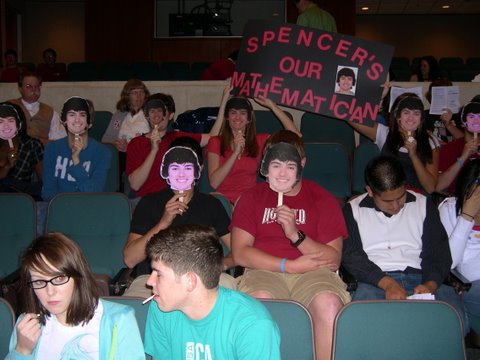HD. The Math Factor Returns!
A quick hello from Chaim and Kyle as the Math Factor returns!
We’ll be the first to say our Coffee Pot Question isn’t our deepest puzzle ever, but it sure did make a difference in Chaim’s life!
A quick hello from Chaim and Kyle as the Math Factor returns!
We’ll be the first to say our Coffee Pot Question isn’t our deepest puzzle ever, but it sure did make a difference in Chaim’s life!
This is the solution to Morris: Trial/Trual/Whatever. Please look there before reading the solution.
It turns out the right word is truel, first coined in 1954 by Martin Shubik.
Kyle and Chaim finally get back into the studio!
We first pose a quick question: If you drive fifty miles in fifty minutes, must there be some ten minute interval in which you drive exactly ten miles?
Of course there must — mustn’t there? Well prove it!
Our main feature this week is an interview with Michael Breen, from the American Mathematical Society, who came and hosted a game show “Who Wants To Be A Mathematician!” About a hundred high school students from all over northwest Arkansas came to cheer on their classmates; Kyle Strong of Har-Ber High in Springdale came in first, winning $1250, and Karan Batra, of Bentonville placed second with $250.
Our interview includes a few sample problems… I guess we shouldn’t list too many of them, in case Micheal wants to recycle them! Mike’s also responsible for the great series of Mathematical Moments posters— check them out!

PS: We opened with the Up To One Million Dollars In Prize Money May Be Given Away gag… Always fun!
We’ve never discussed the famous “Monty Hall Problem” here (though we did talk about it on the radio before we started podcasting). We recently got an interesting letter that highlights the difference between a game like “Let’s Make A Deal” and a game like “Deal or No Deal”.
Mark A. recently wrote us:
Read the rest of this entry »
The ‘expected’ answer is not always the one people choose: Dennis Shasha explains that psychology plays a role in the answer to last week’s puzzle.
As B Boom wrote, the first pirate can make a proposal that gives him all but 49 (about, depending on the rules) pieces of
the gold. Read the rest of this entry »
Bill Poundstone, author of The Prisoner’s Dilemma, tells us some game theory lore, how to model an arms race, and lessons for the good life.
After discussing last week’s Mismatched Pennies Game, Kyle and Chaim are hauled off to jail!
A few months ago, we offered our listeners up to One Million Dollars! Unfortunately, we didn’t have to give away a cent, as Game Theory predicted all along.
This week, to celebrate the recent “rock scissor paper” World Championship, Kyle and Chaim play a game of “mismatched pennies”. Each puts down a penny on the table, choosing to lay the penny down showing heads or tails.
If the pennies both show heads, Chaim wins 3¢; if both show tails, Chaim wins 1¢, and if one is heads and the other tails, Kyle wins 2¢.
Thinking this through, second and triple guessing one’s opponent, is ultimately fruitless, as wonderfully illustrated in this scene from The Princess Bride
(Incidentally, game theory shows up in many movies, television shows and works of fiction!)
John von Neumann tells us, in his celebrated minimax theorem, that there is an optimal strategy for both players; each assigns a percentage to each of his options; the choice of which option to use is made randomly, by these percentages. Von Neumann tells us that there is no way to take advantage of knowing what the opponent’s optimal strategy is– that’s what makes it optimal!
But the game still might favor one player or the other, even if both are using their optimal strategy. This week’s puzzle then, is to answer: does this game of mismatched pennies favor Chaim or Kyle?
We discuss the results of the fabulous Math Factor Million Dollar Giveaway. and confess this was an excuse to bring up Game Theory and how to talk about really big numbers.